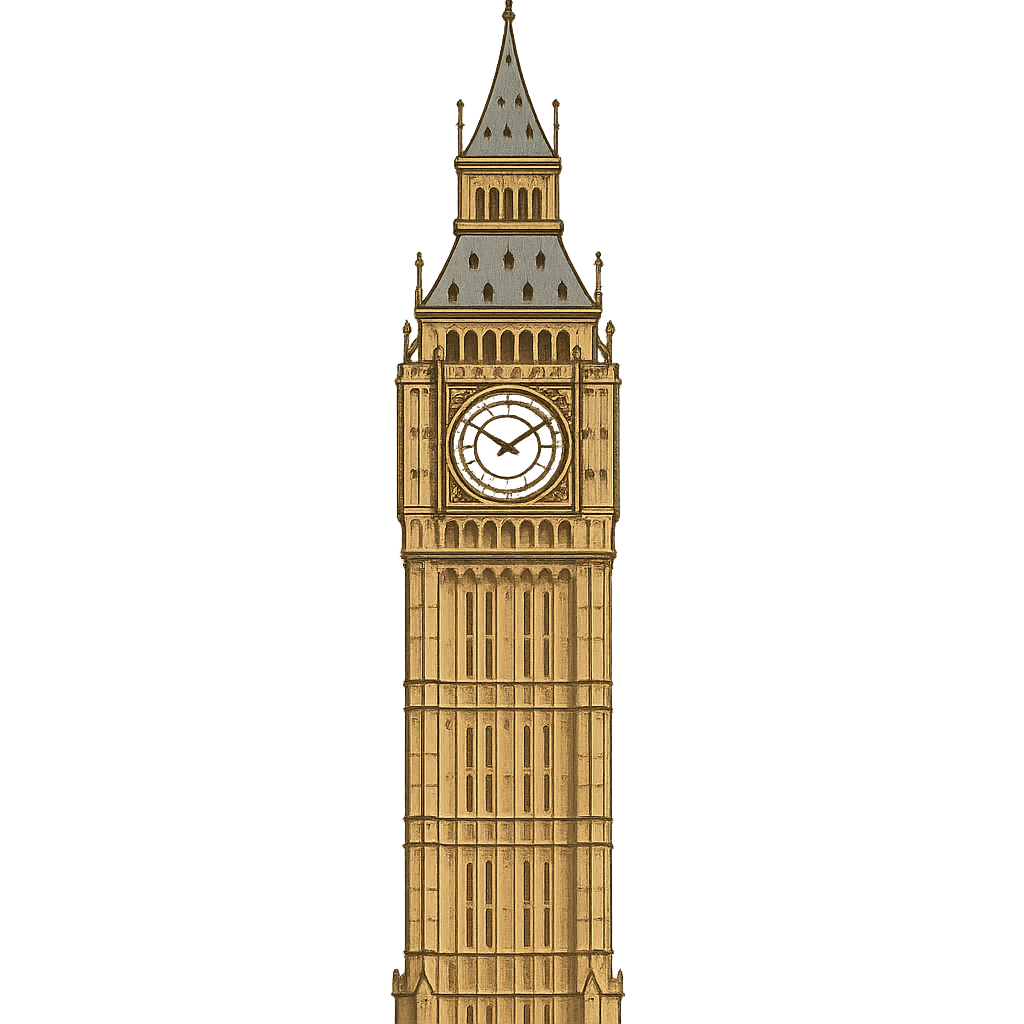The Tower of Time
From my perch high above the city, I feel the rumble in my chest just before it happens. BONG. The sound rolls out, a deep and steady note that travels over the rooftops and along the river. BONG. It is the sound of London itself, a vibration that has marked the hours for generations. Below me, the River Thames winds like a silver ribbon, and the famous double-decker buses look like tiny, crawling ladybugs. I watch over the Houses of Parliament, where important decisions are made, and I see children chasing pigeons in the parks. For more than 160 years, I have been the city’s faithful timekeeper, a constant, watchful guardian. Many people call me Big Ben, and while I love the friendly nickname, it’s a little secret that they are actually calling out to my greatest treasure: the massive bell deep inside me. My true name, given to me in 2012 to honor a long-reigning queen, is the Elizabeth Tower.
My story begins not with a plan, but with a disaster. On the night of October 16, 1834, a terrible fire swept through the old Palace of Westminster, turning the heart of British government to ash and smoke. It was a devastating loss, but from those ashes rose a grand opportunity. The nation decided to build a new, more magnificent home for Parliament. A competition was announced, and in 1836, an architect named Charles Barry was chosen for the monumental task. His design was breathtaking, a modern palace in the grand Gothic style. And as the crowning feature, he envisioned a glorious clock tower—me—to stand as a symbol of the nation's strength, stability, and resilience. Barry was a master of structure, but he knew he needed an artist to make me truly beautiful. He collaborated with Augustus Pugin, a genius of design who sketched my every intricate detail. Pugin gave me my slender shape, my delicate stonework, and my four magnificent clock faces, each one a masterpiece of golden shields and graceful iron hands. Together, they imagined a tower that wasn't just a building, but a work of art that would declare Britain’s confidence to the world.
Building me was a feat of incredible skill, but creating my voice and my heart was a saga all its own. My voice is the Great Bell, the real “Big Ben.” The first attempt to cast it, in 1856, ended in failure when the massive bell cracked during testing. It was a huge setback, but the workers at the Whitechapel Bell Foundry did not give up. In 1858, they successfully cast a new bell, even larger than the first, weighing an astonishing 13.7 tons. Its journey to me was a national celebration. Sixteen powerful white horses pulled the great bell on a carriage through the cheering streets of London. But the biggest challenge was still ahead: hoisting it 200 feet up into my belfry. It took 18 grueling hours of winching to lift my mighty voice into place. Just as important as my voice is my heart: my clock mechanism. This was the work of a brilliant and determined man named Edmund Beckett Denison. He was a lawyer and an amateur clockmaker, but his design was revolutionary. He invented a system called the “double three-legged gravity escapement,” a complex-sounding name for a simple, brilliant idea that ensured my clock would be the most accurate public clock in the world. It was so precise that he famously said it would tick correctly to within one second per day. This marvel of Victorian engineering began ticking on May 31, 1859, and my heart has been beating steadily for London ever since.
For over a century and a half, I have been a silent witness to history. My chimes have marked moments of sorrow and moments of pure joy. During World War II, my bongs were broadcast by the BBC across the globe, becoming a sound of hope and defiance against the darkness. My face was darkened to avoid becoming a target, but my voice could not be silenced. I have bonged in countless New Year’s celebrations, rung for royal weddings and coronations, and marked the solemn moments of Remembrance Day. Recently, from 2017 to 2022, I fell silent for the longest time since I was built. It was time for me to rest and be repaired. Skilled craftspeople carefully cleaned my every stone and polished every numeral on my clock faces. When my chimes finally returned, it was a joyous sound for the entire nation. Today, I stand not just as a timekeeper, but as a symbol of endurance, unity, and the unbreakable spirit of London. I remind everyone that time is always moving forward, bringing with it new beginnings and endless possibilities.
Reading Comprehension Questions
Click to see answer
